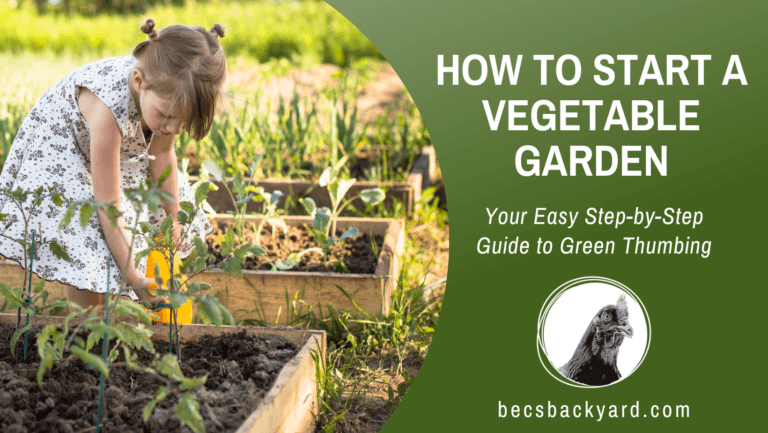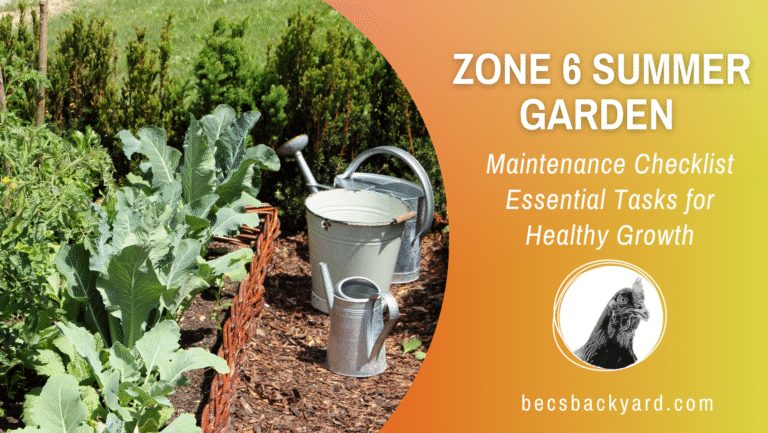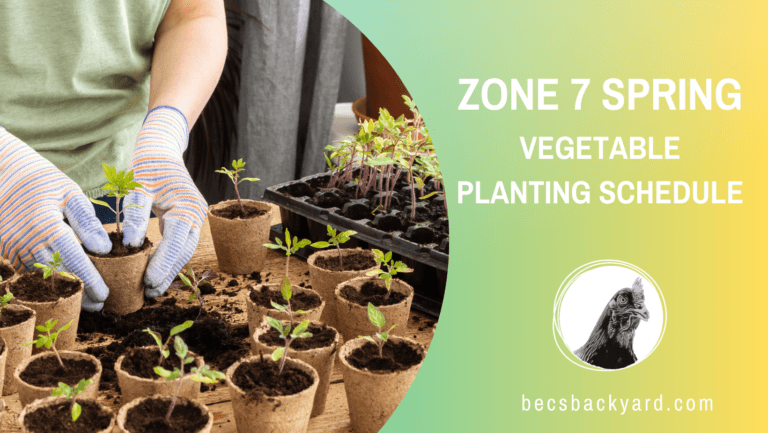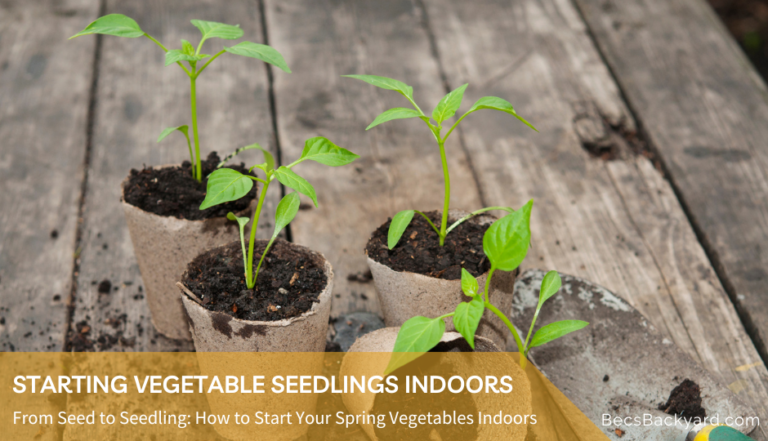Spring Vegetable Seedlings: Tips on Getting Them Started

Spring is a great time to start planting vegetable seedlings. Knowing when to start your spring vegetable seedlings is crucial to ensure a successful harvest. Many factors, such as frost dates and soil temperature, need to be considered when deciding when to start your seeds.
The Farmers’ Almanac suggests starting seeds indoors 5-6 weeks before the transplant date for most vegetables. However, the timing may vary depending on the specific vegetable and your location. To determine the best time to start your seeds, it is essential to know your average frost date and soil temperature. Additionally, it is important to consider the spacing and companion planting suggestions for each crop. With proper planning, you can enjoy a bountiful harvest of fresh spring vegetables.

Understanding Seedlings
When it comes to starting a vegetable garden, understanding seedlings is crucial. Seedlings are young plants that have just sprouted from a seed. They are delicate and require special care to ensure they grow into healthy, mature plants.
When to Start Seedlings
The timing of when to start seedlings depends on various factors such as the type of vegetable, the climate, and the planting zone. Generally, seedlings should be started indoors 6-8 weeks before the last expected frost date in your area. This will give the plants enough time to grow and mature before they are transplanted outdoors.
How to Start Seedlings
Starting seedlings indoors requires a few essential items such as seed trays, potting soil, and grow lights. Fill the seed trays with potting soil and plant the seeds according to the instructions on the seed packet. Keep the soil moist and place the trays under grow lights or in a sunny location. Once the seedlings have grown to a certain size, they can be transplanted into larger containers or directly into the garden.
Common Seedling Problems
Seedlings are vulnerable to various problems such as damping-off, pests, and diseases. Damping-off is a fungal disease that causes the seedlings to wilt and die. To prevent damping-off, ensure that the soil is well-draining and avoid overwatering. Pests such as aphids and spider mites can also damage seedlings. Use natural methods such as neem oil or insecticidal soap to control pests. Diseases such as powdery mildew and blight can be prevented by maintaining good air circulation and avoiding overcrowding of plants.
Conclusion
Starting seedlings can be a fun and rewarding experience. With the right care and attention, seedlings can grow into healthy, mature plants that will provide a bountiful harvest.
Ideal Time to Start Spring Vegetable Seedlings
Factors Influencing Seedling Start Time
When it comes to starting spring vegetable seedlings, there are several factors to consider. The most important factor is the average last frost date in your area. This date will determine when it is safe to transplant your seedlings outside.
Other factors that can influence seedling start time include the type of vegetable you are growing, the amount of sunlight and warmth available, and the length of the growing season in your area. Some vegetables, like tomatoes and peppers, require a longer growing season and should be started indoors earlier than others.
Seasonal Variations
The ideal time to start spring vegetable seedlings can vary depending on the season. In general, you should start your seedlings 6-8 weeks before your average last frost date. However, this can vary depending on the type of vegetable and the climate in your area.
For example, if you live in a colder climate, you may need to start your seedlings earlier to ensure they have enough time to mature before the first frost. On the other hand, if you live in a warmer climate, you may be able to start your seedlings later in the season.
To help determine the ideal time to start your spring vegetable seedlings, you can use a seed-starting date calculator or consult a planting calendar for your area. This will help ensure that your seedlings are ready to go outside at the right time and have the best chance of success.
Types of Spring Vegetable Seedlings
Leafy Greens
Leafy greens are a popular choice for spring vegetable seedlings. They are easy to grow and can be harvested early in the season. Some of the most common leafy greens include lettuce, spinach, and kale.
Lettuce is a quick-growing plant that can be harvested in as little as 30 days. It comes in a variety of colors and textures, from crisp and crunchy to soft and buttery. Spinach is another popular leafy green that is packed with nutrients. It can be harvested in about 45 days and is great for salads or cooked dishes. Kale is a hardy plant that can withstand cooler temperatures and can be harvested in about 60 days. It is a nutrient-dense green that is great for smoothies, salads, or cooked dishes.
Root Vegetables
Root vegetables are another popular choice for spring vegetable seedlings. They are easy to grow and can be harvested early in the season. Some of the most common root vegetables include carrots, beets, and onions.
Carrots are a popular root vegetable that can be harvested in about 70 days. They come in a variety of colors, including orange, purple, and white. Beets are another popular root vegetable that can be harvested in about 60 days. They are packed with nutrients and come in a variety of colors, including red, yellow, and white. Onions are a staple in many dishes and can be harvested in about 90 days.
Fruiting Vegetables
Fruiting vegetables are another popular choice for spring vegetable seedlings. They are easy to grow and can be harvested early in the season. Some of the most common fruiting vegetables include tomatoes, peppers, and cucumbers.
Tomatoes are a popular fruiting vegetable that can be harvested in about 60 days. They come in a variety of colors, including red, yellow, and green. Peppers are another popular fruiting vegetable that can be harvested in about 70 days. They come in a variety of colors, including green, red, and yellow. Cucumbers are a refreshing fruiting vegetable that can be harvested in about 50 days. They are great for salads or pickling.
Indoor Seed Starting Techniques
Seed Germination
Starting your vegetable seeds indoors is a great way to get a head start on your spring garden. Here are some techniques to help ensure successful seed germination:
- Choose a high-quality seed starting mix that is well-draining and sterile. Avoid using garden soil as it can contain diseases and pests that can harm your seedlings.
- Use clean containers with drainage holes and fill them with the seed starting mix. Moisten the mix before planting the seeds.
- Plant the seeds at the recommended depth on the seed packet. Cover the seeds with a thin layer of seed starting mix and gently press down.
- Cover the containers with plastic wrap or a clear plastic dome to create a humid environment for the seeds. Place them in a warm, bright location, such as near a south-facing window or under grow lights.
- Check the soil moisture regularly and water as needed. Avoid overwatering as this can lead to fungal growth and damping off disease.
- Once the seeds have germinated, remove the plastic cover and move the containers to a cooler location with bright, indirect light to prevent the seedlings from becoming leggy.
Transplanting Seedlings
Transplanting seedlings from their containers to the garden can be a delicate process. Here are some tips to help ensure a successful transplant:
- Harden off the seedlings by gradually exposing them to outdoor conditions over the course of several days. Start with just a few hours of sunlight and gradually increase the time and intensity.
- Choose a cloudy day or transplant in the late afternoon to avoid exposing the seedlings to direct sunlight and heat stress.
- Dig a hole slightly larger than the root ball of the seedling and gently remove it from the container. Handle the seedling by the leaves, not the stem, to avoid damaging it.
- Place the seedling in the hole and backfill with soil, gently pressing down to remove any air pockets. Water thoroughly.
- Provide support for tall or top-heavy seedlings with stakes or cages to prevent them from bending or breaking in the wind.
- Mulch around the base of the seedlings to help retain moisture and suppress weeds.
Starting your own vegetable seedlings indoors can be a rewarding and cost-effective way to get a head start on your spring garden. With the right techniques and care, you can enjoy a bountiful harvest of fresh, homegrown produce.
Outdoor Seed Starting Techniques
Direct Sowing
Direct sowing is a simple and straightforward method of starting seeds outdoors. This method involves planting seeds directly into the soil where they will grow, rather than starting them indoors and transplanting them later.
To direct sow seeds, you will need to:
- Choose a planting site with good soil and adequate sunlight.
- Prepare the soil by removing any weeds or debris and loosening the top layer of soil.
- Follow the seed packet instructions for planting depth and spacing.
- Water the soil thoroughly after planting and keep it consistently moist until the seeds germinate.
Direct sowing is a great option for vegetables that don’t transplant well, such as carrots, radishes, and beans. It’s also a good choice if you have limited indoor space or want to save time and effort.

Hardening Off Seedlings
If you start your seeds indoors, it’s important to harden off your seedlings before transplanting them outdoors. Hardening off is the process of gradually exposing your seedlings to outdoor conditions, such as wind and sun, so they can adjust to the change in environment.
To harden off seedlings, you will need to:
- Begin by placing your seedlings outside in a sheltered, shady spot for a few hours each day.
- Gradually increase the amount of time your seedlings spend outside, and gradually expose them to more sunlight and wind.
- Watch your seedlings closely for signs of stress, such as wilting or yellowing leaves, and adjust the amount of exposure as needed.
- After a week or two of hardening off, your seedlings should be ready to transplant into the garden.
Hardening off is important because seedlings that are not properly acclimated to outdoor conditions can suffer from shock and may not survive. By taking the time to harden off your seedlings, you can help ensure their success in the garden.
Caring for Spring Vegetable Seedlings
When it comes to growing spring vegetable seedlings, proper care is essential for their survival and success. Here are some tips to keep your seedlings healthy and thriving.
Watering Regimen
Watering is crucial for seedlings to grow and develop properly. However, it’s important not to overwater them, as this can lead to root rot and other problems. Wait until the top of the growing medium is nearly dry before watering. You can either apply water to the surface or allow your growing medium to wick up water by setting your containers on a shallow pan.
Light Requirements
Seedlings need plenty of light to grow strong and healthy. Ideally, the grow lights should hang 3-4 inches above the seedlings at all times, and be kept on for 12-14 hours a day. An inexpensive outlet timer really comes in handy for this! Be sure to adjust the height of the lights as the seedlings grow to keep them at the optimal distance.
Fertilizer Needs
When seedlings first poke out of the ground, they are still feeding off the food stored in the seed. The first couple of leaves that form are not leaves at all. They are called cotyledons or seed leaves, which are part of the seed or embryo of the plant. Once the true leaves appear, it’s time to start fertilizing. Use a balanced liquid fertilizer, diluted to half strength, once a week. Be sure to follow the instructions on the label carefully and don’t over-fertilize, as this can harm your seedlings.
By following these simple tips, you can give your spring vegetable seedlings the best possible start in life. With proper care and attention, they’ll be ready to transplant into your garden in no time!
Troubleshooting Common Seedling Problems
Damping Off Disease
One common problem that can occur when starting seedlings is damping off disease. This fungal disease can cause seedlings to wilt and die. It is often caused by overwatering, poor air circulation, or contaminated soil or containers.
To prevent damping off disease, make sure to use clean soil and containers, and avoid overwatering your seedlings. You can also improve air circulation by using a fan or opening a window.
Leggy Seedlings
Another common problem with seedlings is leggy growth. This occurs when seedlings grow tall and spindly, often due to a lack of light. Leggy seedlings are weak and can be easily damaged.
To prevent leggy growth, make sure your seedlings are getting enough light. If you are starting seedlings indoors, consider using a grow light. You can also improve air circulation by using a fan or opening a window.
Nutrient Deficiencies
Nutrient deficiencies can also occur in seedlings, especially if they are not getting enough nutrients from the soil or fertilizer. Common nutrient deficiencies include nitrogen, phosphorus, and potassium.
To prevent nutrient deficiencies, make sure to use a high-quality soil or fertilizer that is specifically designed for seedlings. You can also add compost or other organic matter to the soil to improve nutrient levels.
In summary, seedling problems can be caused by a variety of factors, including fungal diseases, lack of light, and nutrient deficiencies. By taking steps to prevent these problems, you can ensure that your seedlings grow strong and healthy.
Frequently Asked Questions
What seeds to start indoors in February
In the northern hemisphere February is a great time to start seeds indoors for many spring vegetables. Some popular options include broccoli, cauliflower, onions, fennel, and lettuces.
Starting vegetable seeds indoors with grow lights
If you don’t have a sunny windowsill, you can start your vegetable seeds indoors with grow lights. This will provide the necessary light for your seedlings to grow strong and healthy.
Spring vegetables to plant
There are many spring vegetables that you can plant, including peas, spinach, lettuce, radishes, and carrots. These vegetables thrive in cooler temperatures and can be planted as soon as the soil can be worked.
Early spring vegetables harvest
Many early spring vegetables can be harvested as soon as they are ready. This includes peas, spinach, and lettuce. These vegetables can be harvested as soon as they are mature, which is typically around 30-60 days after planting.
When should you start seedlings for spring?
The best time to start seedlings for spring depends on your location and the specific vegetables you want to grow. As a general rule, most vegetables should be started indoors 6-8 weeks before your last spring frost date
How big should vegetable seedlings be before transplanting?
Vegetable seedlings should be about 2-3 inches tall before transplanting them into your garden. This will ensure that they are strong enough to survive the transplanting process and will be able to grow strong and healthy in your garden.
Conclusion
Starting spring vegetable seedlings requires careful attention to factors like temperature, light, and moisture. By following the tips outlined in this post and using certified organic seed and seedlings for organic operations, you can help ensure healthy, viable plants for your garden. Remember to transplant seedlings at the right time and use the appropriate growing medium to support their growth. With these best practices in mind, you’ll be well on your way to a successful spring vegetable garden.







